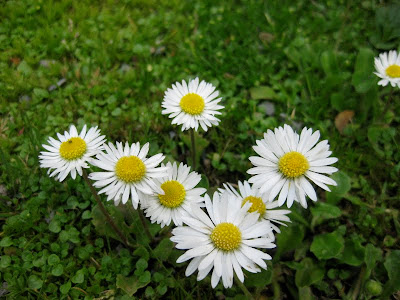 |
| SJG 6/9/11 • Wisteria floribunda, Japanese wisteria/Fuji; 2 of them climbing the trellis in NE corner of the pond; Area K |
 |
| SJG 6/9/11 • Wisteria floribunda, Japanese wisteria/Fuji; Close-up - wisteria vines twine clockwise, or at least our Plant Book says so - I can't see it... |
• Rhododendron hybrid, rhododendron ("Cynthia"?):
 |
| SJG 6/9/11 • Rhododendron hybrid, rhododendron; against E fence; Area M |
 |
| SJG 6/9/11 • Rhododendron hybrid, rhododendron; close-up; Area M |
All four of us on the last Thursday ID-expedition had hoped this spectacular rhododendron blooming right now by the kasuga lantern in NE corner of the Garden (and all over town - Seattle probably being the rhododendron capital of the world) has some exotic name. Alas, it is only marked as 'hybrid'...
I still suspect it has some additional name, to differentiate it from myriad of other R. hybrids - put the 'rhododendron hybrid' into google image and you will see what I mean... Well, I just did it, and the first hit came up as a british poster, depicting exactly what we have, with the description Rhododendron Hybrid "Cynthia"; now I run Rhododendron Hybrid "Cynthia" through google images and came up with pages upon pages of the same reddish-pink huge flower - mainly from British websites, appropriately named 'pictures of england', 'otterhead estate' or 'beautiful gardens uk' - must be really loved there. Here is one from American Rhododendron Society:
 |
| American Rhododendron Society - Photo by: Kenneth Cox |
It came with following description:
Seed Parent x Pollen Parent: catawbiense hybrid
Predominate Flower Color: Pink
Flower / Truss Description: Flower funnel-shaped, 3⅛" across, rose-pink with deeper red staining on the upper lobe. Held in conical trusses of about 24 flowers.
Fragrant: No
Bloom Time: Midseason
Height (ft.) in 10 Yrs: 6
Cold Hardiness Temperature: -15°F (-26°C)
Foliage Description / Plant Habit: Leaves oblong, about 6" long, medium green, hang down in winter months. Dome-shaped habit. Sun and heat tolerant.
So, Rhododendron Hybrid by kasuga lantern: is thy name 'Cynthia"?
If it is, here is an interesting write-up on cultivating your family of plants on the west coast USA (Mendocino Coast Botanical Gardens in CA), with a beautiful pic, as well:
[...]Mr. Schick also donated his collection of big-leaf Rhododendrons. These do not bloom till they reach the age of ten years or more; their leaves may grow to 25 inches in length. They do well near streams and many of them have been planted along Digger Creek.
[...] Tender species rhododendrons are found between 25 and 35 degrees latitude at elevations between 4000 and 9000 feet in their native habitats in Burma, China and Tibet. Growing on steep slopes in temperate rain forests, they require shelter from wind and direct sun, excellent drainage, and temperatures between 20 and 70 degrees F. This combination of climatic elements is hard to find anywhere outside their native ranges. Small areas of New Zealand, southeast Australia, southern coastal Chile and a limited part of South Africa have similar climates.[...]
• Acer palmatum 'Omato', Japanese maple:
 |
| SJG 6/9/11 • Acer palmatum 'Omato', Japanese maple - red leaf, on island between paths; Area K |
 |
| SJG 6/9/11 • Acer palmatum 'Omato', Japanese maple - red leaf close-up; Area K |
 |
| SJG 6/9/11 • Acer palmatum 'Omato', Japanese maple - samara (seed) close-up; Area K |
A samara is a type of fruit in which a flattened wing of fibrous, papery tissue develops from the ovary wall. A samara is a simple dry fruit and indehiscent (not opening along a seam). They are winged achenes. The shape of a samara enables the wind to carry the seed farther away than regular seeds from the parent tree:
• The seed can be in the centre of the wing, as in the elms (genus Ulmus) and the hoptree (Ptelea trifoliata).
• The seed can be on one side, with the wing extending to the other side, making the seed autorotate as it falls, as in the maples (genus Acer) and ashes (genus Fraxinus).
A samara is sometimes called a key and is often referred to as a whirlybird, helicopter, whirligig, polynose, or, in the north of England, a spinning jenny.
Some species that normally produce double samaras, such as Acer pseudoplatanus, can also produce a few multi-lobed samaras with 3 or 4 seeds.
• Rhododendron 'Caroline Gable', azalea:
 |
| SJG 6/9/11 • Rhododendron 'Caroline Gable', small azalea by the water, corolla carmine pink, hose in hose; N side of the pond, Area Q |
 |
| SJG 6/9/11 • Rhododendron 'Caroline Gable', azalea, close-up; Area Q |
 |
| SJG 6/9/11 • Rhododendron 'Caroline Gable', azalea - better view of the double flower (hose in hose): Area Q |
• Unplanted, wild and ubiquitous:
Japanese Garden is generally NOT about flowers, and the ones present are supposed to be 'natural' to the habitat (meaning no exotic roses or dahlias, not even tulips or cosmos), which is why SJG was specifically designed with over-abundance of rhodies - they are natural to PNW habitat and very much loved here (Rhododendron IS Washington state's official flower). I'm pretty sure the gardeners do not weed-out crocuses and snowdrops in winter (no proof, the garden is closed in winter), just as the small daisies and buttercups are allowed to stay through spring:
 |
| SJG 6/9/11 • small daisies grow in the grassy carpet of the orchard |
 |
| SJG 6/9/11 • and so are buttercups |
• Added BONUS in June (thanks to daisies and buttercups):
Virginia Tech has a nice "weed guide" site with excellent pictures.
- Virginia Tech Weed Identification Guide entry for Chrysanthemum leucanthemum (daisy)
- Virginia Tech Weed Identification Guide entry for Ranunculus bulbosus (buttercup).
No comments:
Post a Comment